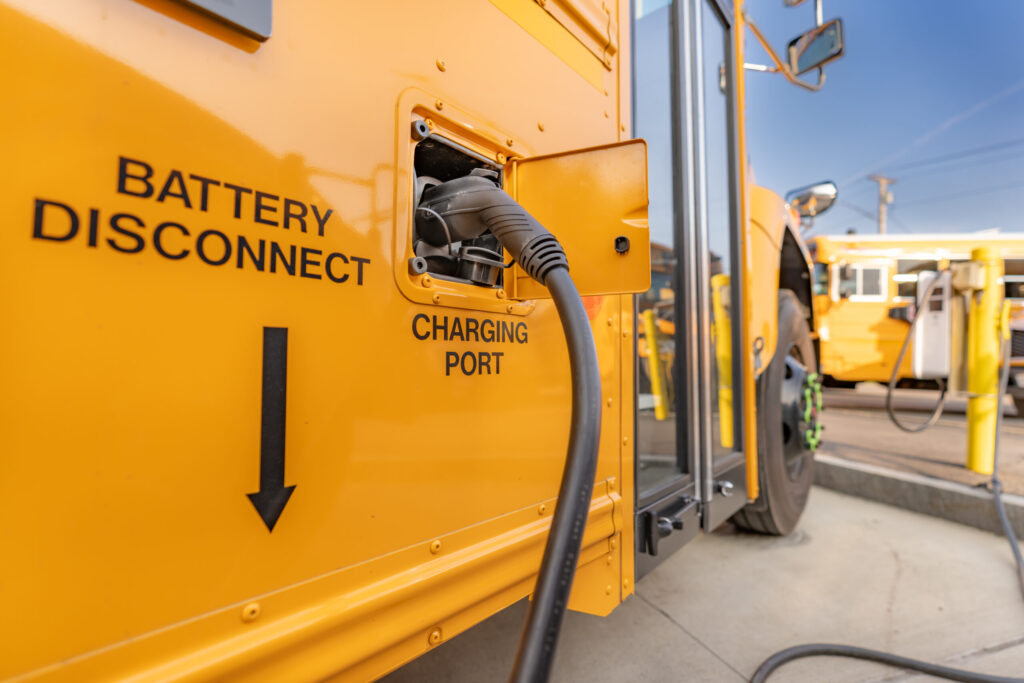The Biden administration on Wednesday said it will provide funding to help school districts purchase clean school buses, most of them electric. Shown is a yellow electric school bus plugged into a charging station. (Photo by TW Farlow/Getty Images)
Along with new tax breaks for families and businesses in return for investing in clean and more efficient energy, the federal government is for the first time offering support to schools and other nonprofits that make those investments.
“Direct support” payments from the Internal Revenue Service will pay back school districts, churches and other nonprofit organizations for part of what they spend on energy renovations that cut their energy use and replace fossil fuels.
For schools the program represents an opportunity to make energy upgrades that many have had to skimp on, according to Nathan Ugoretz, secretary-treasurer of the Wisconsin Education Association Council.
As state school funding falls behind the rising costs public school districts face, “funding for maintenance and improvements have been put on the chopping block,” Ugoretz said Thursday. School districts across Wisconsin have held referendum votes to raise property taxes to support ongoing expenses.
“This leaves no resources for overhauling outdated electrical systems or investments to cut energy costs,” Ugoretz said.
Ugoretz spoke at Forest Edge Elementary School, a Fitchburg school that has been singled out for its strides in improving energy efficiency. In 2021, the school, after operating for just one year, was recognized as the first Net Zero Energy school in Wisconsin — producing and returning to the power grid as much energy as it used.
The BlueGreen Alliance, an advocacy group that combines the interests of the labor and environmental movements, chose the school Thursday for a presentation on how clean energy and energy efficiency tax credits under the 2022 Inflation Reduction Act are available to more than just taxpayers, whether individuals or businesses.
Direct IRS support that passes those tax credits on to nonprofits will help accelerate the spread of green technology to more users, participants in Thursday’s event said.
“That is a really, really big deal — not only because we get to model for our students what a clean energy economy looks like, but because utility costs for schools are one of the biggest demands on school budgets,” said Kristina Costa, deputy assistant to President Joe Biden for clean energy innovation and implementation. “And when energy costs go up, that leaves fewer resources available for everything else that students need to do.”
Cutting those costs by boosting energy efficiency “frees up those precious dollars to improve our schools and in other ways to enrich our kids’ education,” Costa added.
Spurred by the Inflation Reduction Act, businesses have invested $1.7 billion on clean power projects in Wisconsin through May 2024, according to the White House.
“This is a win, win, win,” said Rep. Mark Pocan (D-Town of Vermont) — for improving education resources, for labor and “more professional job development to have good wages and benefits. Pocan praised the Biden administration for taking “the high road,” adding, “it’s a win for the environment because ultimately we’re addressing climate change through addressing the rising cost of energy.”
Forest Edge school was built well before the Inflation Reduction Act was signed into law, but as Wisconsin’s first net-zero energy school, “it’s an example of what’s possible for schools across the state,” state Carly Eaton, Wisconsin policy manager for BlueGreen Alliance.
From the start the Oregon School District facility was developed to be as energy efficient and clean-energy focused as possible, school district officials said.
A total of 1,704 solar panels line the flat rooftops of the building, providing enough electricity that the district is able to sell some of it back to the power grid, according to Andy Weiland, Oregon School District business manager. Walls of glass maximize natural light in the building, while the panes are specially treated to darken automatically in sunlight to prevent the building interior from heating up.
Geothermal energy, which draws heat from deep below the earth’s surface, and heat pump technology warm the school — and also keep it cool when the weather outside is warm.
“For the most part we don’t have to use any fossil fuels at all,” Weiland said as he gave a tour of the building Thursday.
Had the district been able to use the Inflation Reduction Act’s direct support program when it was building the school, the savings, Weiland speculated, “would have been several million dollars.”
Beyond the savings that the act promises for people and organizations that use its incentives to upgrade their energy systems, the legislation has also been championed for provisions that require contractors to pay employees prevailing local wages on projects that qualify for the full values of tax credits. It also requires projects to employ participants in licensed apprenticeship programs.
The two requirements help stabilize the construction workforce, said Emily Pritzkow, executive director of the Wisconsin Building Trades Council, which represents about 40,000 Wisconsin members in several construction unions.
“By utilizing competitive labor standards, including an area’s standard wages, benefits and training opportunities, we are ensuring the economic impact of these projects stays in our local community for generations to come,” Pritzkow said.
GET THE MORNING HEADLINES DELIVERED TO YOUR INBOX
The post Federal clean energy program includes incentives for nonprofits appeared first on Wisconsin Examiner.

